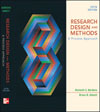 Research Design and Methods: A Process Approach, 5/e Kenneth S. Bordens,
Indiana University/Purdue University - Fort Wayne
Bruce Barrington Abbott,
Indiana University/Purdue University
Using Nonexperimental Research
Chapter OutlineConducting Observational Research
Developing Behavioral Categories
Quantifying Behavior in an Observational Study
Frequency Method
Duration Method
Intervals Method
Recording Single Events or Behavior Sequences
Coping with Complexity
Time Sampling
Individual Sampling
Event Sampling
Recording
Establishing the Reliability of Your Observations
Percent Agreement
Cohen's Kappa
Pearson's Product-Moment Correlation
Dealing with Data From Multiple Observers
Sources of Bias in Observational Research
Qualitative Approaches
Naturalistic Observation
Making Unobtrusive Observations
Ethnography
Observing as a Participant or Nonparticipant
Gaining Access to a Field Setting
Gaining Entry Into the Group
Becoming Invisible
Making Observations and Recording Data
Analyzing Ethnographic Data
Born to Be Wild: An Example of Ethnography
Evaluation of the Ethnography of the HDSC
Sociometry
An Example of Sociometry
The Case History
Archival Research
Content Analysis
Defining Characteristics of Content Analysis
Performing Content Analysis
Limitations of Content Analysis
Content Analysis: An Example
Meta-analysis: A Tool for Comparing Results Across Studies
Step 1: Identifying Relevant Variables
Step 2: Locating Relevant Research to Review
Step 3: Doing the Meta-Analysis
Drawbacks to Meta-Analysis
Assessing the Quality of the Research Reviewed
Combining and Comparing Studies Using Different Methods
Practical Problems
Do the Results of Meta-Analysis Differ from Those of Traditional Reviews?
Summary
Key Terms |
| 


 2002 McGraw-Hill Higher Education
2002 McGraw-Hill Higher Education